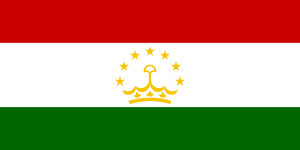
| Colors | HEX Code | RGB | CMYK |
|---|---|---|---|
| Red | #B80404 | 184, 4, 4 | 0, 98, 98, 28 |
| White | #FFFFFF | 255, 255, 255 | 0, 0, 0, 0 |
| Green | #006600 | 0, 102, 0 | 100, 0, 100, 60 |
| Yellow | #F8C300 | 248, 195, 0 | 0, 21, 100, 3 |
The Flag of Tajikistan has three horizontal stripes colored red on top, white in the middle, and green on the lower stripe. There is a golden crown with seven five-pointed stars that are arranged in the form of an arc around the crown, depicted on the central stripe of the flag.
Meaning of the Flag of Tajikistan
The red color in the flag of Tajikistan is a symbol of struggle and the self-sacrifice of its people for freedom and independence. The white color is a symbol of happiness, aspiration and hope, in addition to the cotton crop produced in the country. The green color represents prosperity, pride and eternity, in addition to the Islamic religion. The image of a crown and seven stars is a sign of the historical roots of the independent Tajikistan. The seven stars were chosen due to the importance of number 7 in the Tajik culture. The flag represents unity among people, in addition to the cultural heritage, ideals and aspirations of the people of Tajikistan.
History of the Tajikistan Flag
Tajikistan was part of the Persian Empire, then it became a Russian colony. Tajikistan became a Soviet Socialist Republic in 1924, and its flag was a red field with the Soviet emblems of a hammer, sickle and star in the canton. In 1953, Tajikistan added two horizontal stripes of white and green to the flag. In 1991, when the Soviet Union collapsed, Tajikistan became an independent country. It removed the Soviet emblems from the flag. In 1992, Tajikistan changed its flag to include the three colors of red, green and white, and the crown with stars in the middle. The flag was approved on November 24, 1992.